Conference Location
 Brno by population and area is the second largest city in the Czech Republic, the largest Moravian city, and the historical capital city of the Margraviate of Moravia. Brno is the administrative centre of the South Moravian Region where it forms a separate district Brno-City District. The city lies at the confluence of the Svitava and Svratka rivers and has over 400,000 residents. Brno by population and area is the second largest city in the Czech Republic, the largest Moravian city, and the historical capital city of the Margraviate of Moravia. Brno is the administrative centre of the South Moravian Region where it forms a separate district Brno-City District. The city lies at the confluence of the Svitava and Svratka rivers and has over 400,000 residents.
|
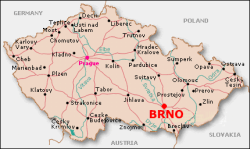
|
History
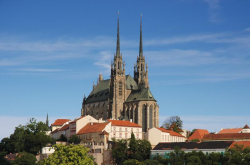
|
Although the Brno basin has been inhabited since prehistoric era, the direct predecessor of Brno, however, was a fortified settlement of the Great Moravia Empire known as Staré Zámky which was inhabited from the Neolithic Age to the early 11th century. In the early 11th century Brno was established as a castle of non-ruling Princes from the House of Přemyslid, and Brno became one of the centres of Moravia along with Olomouc and Znojmo.
|
|
In the 11th century, a chapel was founded on Petrov hill, and since then, the chapel has undergone many changes which after centuries resulted in the current Gothic Cathedral of St. Peter and Paul. The Spilberk Castle was founded in the 13th century, originally as the major royal castle in Moravia.
|
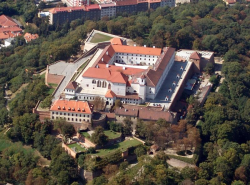
|
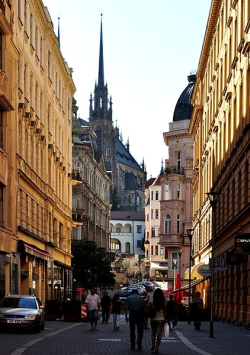
|
In 1243 Brno received the large and small city privileges from the King, and thus it was recognized as a royal city. In 1324 Queen Elisabeth Richeza of Poland (cz: Eliška Rejčka) founded the current Basilica of the Assumption of Our Lady where is now her final resting place. In the 14th century, Brno became one of the centres for the Moravian regional assemblies, whose meetings alternated between Brno and Olomouc. These assemblies made political, legal, and financial decisions. Brno and Olomouc were also the seats of the Land Court and the Land Tables, thus they were the two most important cities in Moravia. From the mid of 14th century to the early 15th century the Spilberk Castle had served as the permanent seat of the Margraves of Moravia (Moravian rulers), one of them was elected the King of the Romans.
|
|
From the mid 11th century onwards, Moravia was divided into three separate territories; each one of them had its own ruler independent of the other two. Seats of these rulers and thus "capitals" of these territories were the castles/towns of Olomouc, Znojmo, and Brno. In the late 12th century, Moravia began to reunify, forming the Margraviate of Moravia. From that time until the mid 17th century, it was not clear which town should be the capital of Moravia. Political power was therefore "evenly" divided between Brno and Olomouc but Znojmo also played an important role.
|
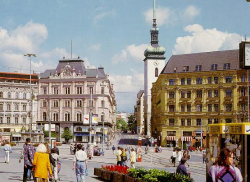
|
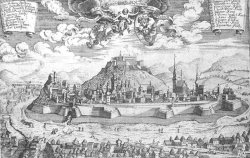
|
The Moravian Diet (cz: zemský sněm), the Moravian Land Tables (cz: zemské desky), and the Moravian Supreme Court (cz: zemský soud) were all seated in both cities at once. Olomouc was the second largest city of the Czech Crown lands (after Prague), it was the seat of the only bishopric in Moravia (later the archbishopric), and since 1573 also of the only Moravian university. Brno was the seat of Moravian Margraves (rulers of Moravia), and later its closer geographic position to Vienna also became important for its future.
|
|
In 1641, in the midst of the Thirty Years' War, the Holy Roman Emperor and Margrave of Moravia Ferdinand III commanded the permanent relocation of the diet, court, and the land tables from Olomouc to Brno, as Olomouc's Collegium Nordicum made it one of the primary targets of Swedish armies. From 1642 to 1650 Olomouc was occupied by the Swedish army, which led to decline in population from over 30.000 people to mere 1.675 and total devastation of the city. Meanwhile Brno, as the only Moravian city which managed to defend itself, flourished.
|
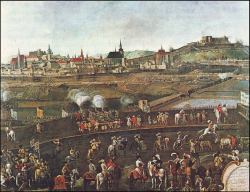
|

|
1641 was also the year Brno became the only capital of Moravia. During the 17th century the Spilberk Castle was rebuild into a huge baroque citadel. In 1777 the Brno Bishopric was established. In 1839 the first train arrived to Brno from Vienna, this event was the beginning of rail transport in the today's Czech Republic. In the years 1859-1864 the city fortification was almost completely removed.
|
|
In 1869 a horse car service started to operate in Brno, it was the first tram service in today's Czech Republic. From that time onwards, the only capital city of Moravia was Brno, until 1948 when the communist government finally abolished Moravian autonomy. At the present, the Moravian Land Tables are stored in the Moravian Regional Archive, and rank among the national cultural sights of the Czech republic.
|
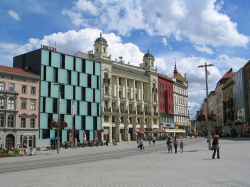
|

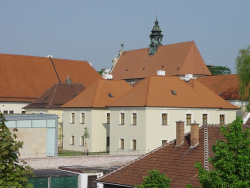
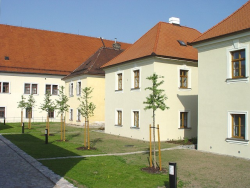

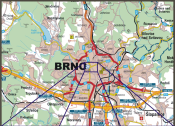
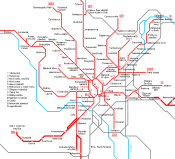
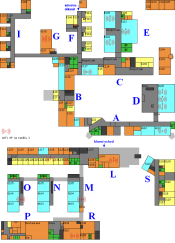



 Brno by population and area is the second largest city in the Czech Republic, the largest Moravian city, and the historical capital city of the Margraviate of Moravia. Brno is the administrative centre of the South Moravian Region where it forms a separate district Brno-City District. The city lies at the confluence of the Svitava and Svratka rivers and has over 400,000 residents.
Brno by population and area is the second largest city in the Czech Republic, the largest Moravian city, and the historical capital city of the Margraviate of Moravia. Brno is the administrative centre of the South Moravian Region where it forms a separate district Brno-City District. The city lies at the confluence of the Svitava and Svratka rivers and has over 400,000 residents.









 Tel.: +420 54114 1144
Tel.: +420 54114 1144 Fax: +420 54114 1270
Fax: +420 54114 1270 Email:
Email: 






















